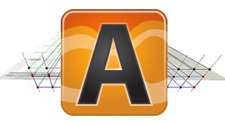
The AMBER software tool that allows users to build their own deterministic and probabilistic compartment models has undergone a major upgrade , including spatial awareness and 3D visualisation of models (AMBER 6.0). In addition, AMBER 6.0 has a significant update to the user interface that further improves its user-friendliness, while being consistent with the look and feel of previous versions of AMBER, and also cross-platform support, for running on Windows and Linux operating systems.
Spatial Awareness
The majority of models implemented in AMBER are spatial in their essence. Traditionally, these types of models are implemented in contaminant transport modelling codes by the user having to painstakingly hard-wire spatial properties into 2D representations.
With the new software release, users have the option of assigning spatial dimensions, which means that compartments can be defined in three-dimensional space through associated x,y,z co-ordinates. AMBER is then able to automatically calculate a range of properties that can be used in the contaminant transport calculations, including compartment volumes, interface areas and transfer distances.
3D Visualisation
Coupled with the spatial awareness, AMBER 6.0 includes a completely new way of visualising the contaminant transport models. The spatial component of the models can be set-up and explored within a three-dimensional framework. Spatial models are created by defining x,y points on a planar surface which can be built around a map of the area to be represented. Depth and height of the spatial 'cells' are then defined by assigning z co-ordinates. The structure can then be explored in three-dimensions so that users can fully visualise their models.
The new capabilities enable AMBER users to build spatial models effeciently and to visualise the resulting structure and discretisation in 3D. These features provide a unique modelling capability for this calibre of contaminant transport and fate code. They will also form the basis of future enhancements, including allowing the structure of spatial models to change with time and the capability to render time-dependent properties and results onto the 3D view.
New User Interface
The user interface for AMBER has been completely redeveloped in the new version. Reliance on multiple separate windows and dialogues has been replaced with a more integrated and flexible interface built around tabs and panels. The main tabs can be split so that multiple aspects of the model can be viewed at the same time, increasing the amount of information that is immediately available to the user. In addition, a full undo/redo capability has been built into the new interface from the start, which is a further useful feature for AMBER users.
AMBER Support
Quintessa continues to support AMBER, both through applying the software to safety and performance assessment studies of contaminants in the environment and in supporting the AMBER user base. Feel free to contact us if you have any questions about AMBER, its application and/or about our support programme.
For information on some recent applications of AMBER please view the latest AMBER Update newsletter.